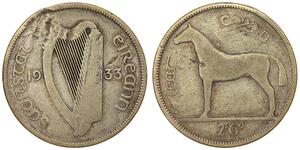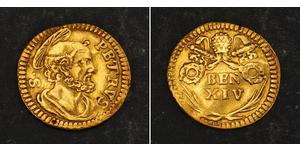[ 3871] THESSALY: KRANNON Bronze (17mm, 4.64 gm.) Struck c.400-344 B.C. Reference: BMC 7.5. Horseman galloping right. Hydria, mounted on wheels; K - PA / NNO in field. Situated near the source of the river Onchestos, the citizens of Krannon held Poseidon in especially high regard. Provided with certificate of authenticity. CERTIFIED AUTHENTIC by Sergey Nechayev, PhD - Numismatic Expert Krannonas (Modern Greek: Κραννώνας; ancient city: Κραννών, Crannon) is a village and a municipality in the Larissa Prefecture, Greece located southwest of the regional capital. Its 2001 population was 104 for the village, 185 for the municipal district and 3,274 for the municipality (1.17% of the prefectural population). The seat of the municipality is Agioi Anargyroi. It is connected with the road linking Karditsa and Larissa. It is also located north of Farsala and NNE of Palamas and Karditsa. Geographically the municipal boundaries extend as far south as the Fyllio Mountains (where Enipeas as bordered as its highest point is 533 m, as far north as Koilada and Larissa and along with the Larissa metropolitan area and as far east as Nikaia and as west with the Karditsa prefecture. One of the panoramic views includes its nearby mountains to the west, Mount Olympus to the north, Ossa to the northeast and Chalkodonio to the south. Krannonas was a site of the decisive battle of the Lamian War between Macedon and Athens with allies. Thessaly was home to an extensive Neolithic culture around 2500 BC. Mycenaean settlements have also been discovered, for example at the sites of Iolcos, Dimini and Sesklo (near Volos). Later, in ancient Greek times, the lowlands of Thessaly became the home of baronial families, such as the Aleuadae of Larissa or the Scopads of Crannon. These baronial families organized a federation across the Thessaly region, later went on to control the Amphictyonic League in northern Greece. The Thessalians were renowned for their cavalry. In the summer of 480 BC , the Persians invaded Thessaly. The Greek army that guarded the Vale of Tempe , evacuated the road before the enemy arrived. Not much later, Thessaly surrendered. The Thessalian family of Aleuadae joined the Persians. In the Peloponnesian War the Thessalians tended to side with Athens and usually prevented Spartan troops from crossing through their territory with the exception of the army of Brasidas. Jason of Pherae briefly transformed the country into a significant military power, though he was assassinated before any lasting achievements were made. In the 4th century BC Thessaly became dependent on Macedon and many served as vassals. In 148 BC the Romans formally incorporated Thessaly into the province of Macedonia, though in 300 AD Thessaly was made a separate province with its capital at Larissa. It was part of the Byzantine Empire and suffered many invasions. In 977 it was occupied by the Bulgarians, who remained there until 1014. In 1204 he was assigned to Boniface of Montferrat and in 1225 to Theodore Komnenos Doukas, despot of Epirus. From 1271 to 1318 he was an independent despotate that extended to Acarnania and Aetolia, run by John III Angelos Komneno. In 1309 settled there the Almogavars or Catalan Company of the East (Societas Catalanorum Magna), which in 1310, after lifting the siege of Thessalonica, withdrew as mercenaries in the pay of the sebastocrátor John II, and took over the country organized in a democracy. From there went to the Duchy of Athens called by the duke Walter I. In 1318, with the extinction of the dynasty of Angelos, the Almogavars occupied Siderocastron and southern Thessaly (1319) and formed the duchy of Neopatria. Later it was occupied by the Serbs until 1393, after being dominated by the Ottomans. In 1821 participated in the Greek War of Independence, but was not recognized as part of Greece until 1881. Payment & Shipping: Will accept payments via PayPal. = MM_contentVersion;
}
else if (navigator.userAgent ...
Mehr...

|
Beigetragen von:
anonymous 2015-08-19 |
Similar Coin Groups

2 Kopeke Russisches Reich (1720-1917) K ...
Diese Gruppe hat 12 Münzen / 8 Preise
Add coin to this group

10 Mark Deutsche Demokratische Republik ...
Diese Gruppe hat 9 Münzen / 9 Preise
Add coin to this group

2/3 Thaler Fürstentum Ansbach (1398–1792 ...
Diese Gruppe hat 7 Münzen / 6 Preise
Add coin to this group

1/2 Sovereign Vereinigtes Königreich von ...
Diese Gruppe hat 7 Münzen / 5 Preise
Add coin to this group

2 Ore Schweden Adolf Frederick of Swede ...
Diese Gruppe hat 4 Münzen / 4 Preise
Add coin to this group
2025-06-14
- New coin is added to 1/2 Crown Irland (1922 - )
1/2 Crown Irland (1922 - )
Diese Gruppe hat 44 Münzen / 43 Preise
⇑
Ireland - 1/2 Crown / 2 Shillings 6 Pence 1933 - Horse , Silver
2025-05-24
- New coin is added to 1/2 Scudo Vatikanstadt Gold
1/2 Scudo Vatikanstadt Gold
Diese Gruppe hat 5 Münzen / 5 Preise
⇑
ITALIA Vaticano - Stato Pontificio Benedetto XIV. 1740-1758. 1/2 Scudo romano 1741, Roma. 0.91 g. Berman 2735. Fr. 233. BB+.
Das könnte Sie auch interessieren:

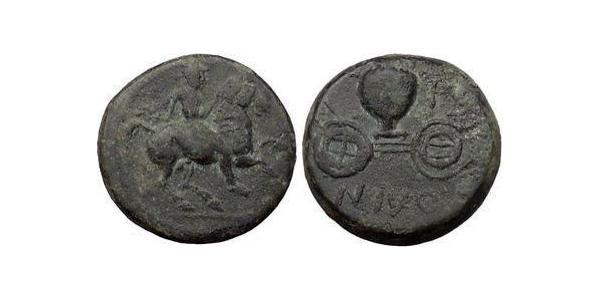



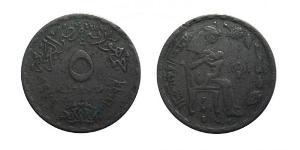
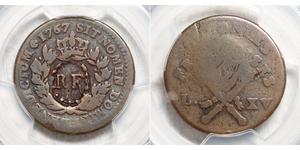


-300-150-cqgKbzbiQeMAAAFLYpCjltiK.jpg)
